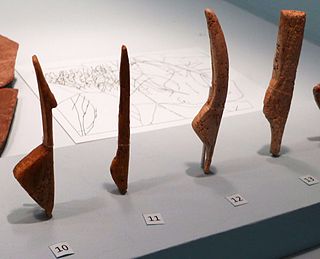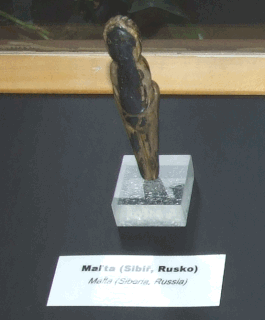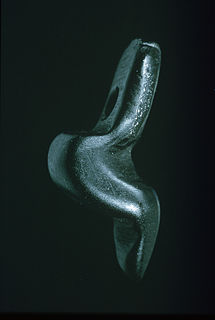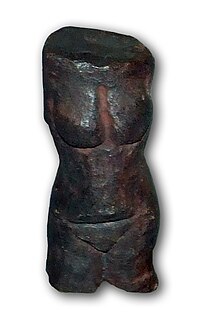 W
WA Venus figurine is any Upper Palaeolithic statuette portraying a woman, usually carved in the round. Most have been unearthed in Europe, but others have been found as far away as Siberia, and distributed across much of Eurasia.
 W
WThe Venus figurines of Balzi Rossi from the caves near Grimaldi di Ventimiglia (Italy) are thirteen Paleolithic sculptures of the female body. Additionally, two small depictions of the human head were discovered at the same place. The age of these figurines cannot be determined because of missing archaeological context data. It is usually accepted that these figurines stem from the Gravettian, about 24,000 to 19,000 years old. Most of the sculptures consist of steatite and are between 2.4 and 7.5 cm in height. Between 1883 to 1895 the figurines were discovered by the antique dealer Louis Alexandre Jullien at the cave complex Balzi Rossi at the Ligurian coast. Eight of these sculptures are housed in the museum Saint-Germain-en-Laye near Paris.
 W
WThe Venus of Berekhat Ram is a pebble found at Berekhat Ram on the Golan Heights. The pebble was modified by early humans and is suggested to represent a female human figure.
 W
WThe Venus of Brassempouy is a fragmentary ivory figurine from the Upper Palaeolithic, apparently broken from a larger figure at some time unknown. It was discovered in a cave at Brassempouy, France in 1892. About 25,000 years old, it is one of the earliest known realistic representations of a human face.
 W
WThe Venus of Dolní Věstonice is a Venus figurine, a ceramic statuette of a nude female figure dated to 29,000–25,000 BCE. It was found at the Paleolithic site Dolní Věstonice in the Moravian basin south of Brno, in the base of Děvín Mountain, 549 metres (1,801 ft). This figurine and a few others from locations nearby are the oldest known ceramic articles in the world.
 W
WThe Venus of Galgenberg is a Venus figurine of the Aurignacian era, dated to about 30,000 years ago. The sculpture, also known in German as the Fanny von Galgenberg, was discovered in 1988 close to Stratzing, Austria, not far from the site of the Venus of Willendorf. The two statuettes are normally displayed in the same cabinet at the Museum of Natural History in Vienna, to emphasise the special nature of these two "old ladies", as the curator affectionately calls them.
 W
WThe Venus figurines from Gönnersdorf, at Neuwied, are paleolithic sculptures depicting the female body.
 W
WThe Venus of Hohle Fels is an Upper Paleolithic Venus figurine made of mammoth ivory that was unearthed in 2008 in Hohle Fels, a cave near Schelklingen, Germany. It is dated to between 40,000 and 35,000 years ago, belonging to the early Aurignacian, at the very beginning of the Upper Paleolithic, which is associated with the earliest presence of Cro-Magnon in Europe.
 W
WThe Vénus impudique is the first Paleolithic sculptural representation of a woman discovered in modern times. It was found by Paul Hurault, 8th Marquis de Vibraye in about 1864 at the famous archaeological site of Laugerie-Basse in the Vézère valley.
 W
WThe Venus figurines of Kostenki are prehistoric representations of the female body, usually in ivory and usually dated to between 25,000 and 20,000 years ago, making them part of the Gravettian industry of the Upper Palaeolithic period. Found in the Kostyonki-Borshchyovo archeological complex in Russia, these Venus figurines are now in the Hermitage Museum.
 W
WThe Venus of Lespugue is a Venus figurine, a statuette of a nude female figure of the Gravettian, dated to between 26,000 and 24,000 years ago.
 W
WThe Venus figurines of Gagarino are eight Palaeolithic Venus figurines made from ivory. The statuettes belong to the Gravettian industry and are about 21,000–20,000 years old. They were discovered near to the village of Gagarino in Lipetsk Oblast, Russia, and are now held in the Hermitage Museum in Saint Petersburg.
 W
WThe Venus figurines of Mal’ta are several palaeolithic figurines of women found in Siberia, Russia.
 W
WThe Venus of Mauern is a Venus figurine from the paleolithic era. The statuette stems from the Gravettian and is about 27.000 years of age. The figurine consists of red painted limestone and was found in 1948 in Mauern (Rennertshofen). It is housed in the Archäologische Staatssammlung in Munich.
 W
WThe Venus of Monruz is a Venus figurine of the late Upper Paleolithic, or the beginning Epipaleolithic, dating to the end of the Magdalenian, some 11,000 years ago. It is a black jet pendant in the shape of a stylized human body, measuring 18 mm in height. It was discovered in 1991, at the construction of the N5 highway, at Monruz in the municipality of Neuchâtel, Switzerland.
 W
WThe Venus of Moravany is a small prehistoric female figurine discovered in Slovakia in the early 20th century.
 W
WThe Venus figurines of Petersfels are several small female statuettes from the Upper Paleolithic era, carved from jet lignite. The tallest figurine is called the Venus of Engen. The figurines were discovered in the Petersfels caves near Engen, Baden-Württemberg, excavated in 1927–1932 by Eduard Peters und Volker Toepfer and then in 1974–1976 and 1978 by Gerd Albrecht. They stand between 1.5 and 4 cm tall and are about 15,000 to 11,500 years old, created during the Magdalenian era. They are housed in the Museums of Freiburg im Breisgau and Engen.
 W
WThe Venus of Petřkovice is a pre-historic Venus figurine, a mineral statuette of a nude female figure, dated to about 23,000 BCE in what is today the Czech Republic.
 W
WThe Venus of Tan-Tan is an alleged artifact found in Morocco. It and its contemporary, the Venus of Berekhat Ram, have been claimed as the earliest representations of the human form.
 W
WThe Venus of Willendorf is an 11.1-centimetre-tall (4.4 in) Venus figurine estimated to have been made around 25,000 years ago. It was found on August 7, 1908, by a workman named Johann Veran or Josef Veram during excavations conducted by archaeologists Josef Szombathy, Hugo Obermaier, and Josef Bayer at a Paleolithic site near Willendorf, a village in Lower Austria. It is carved from an oolitic limestone that is not local to the area, and tinted with red ochre. The figurine is now in the Natural History Museum in Vienna, Austria.